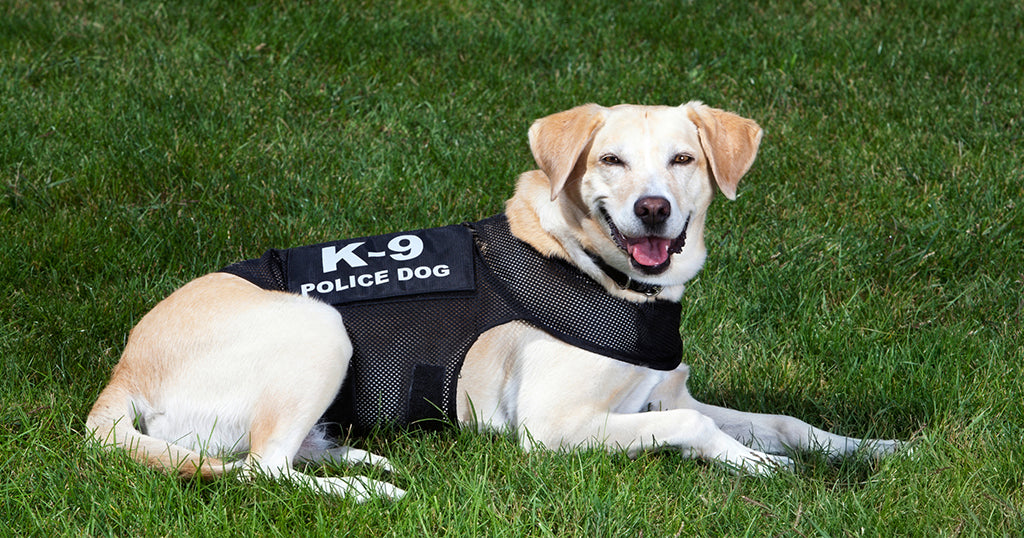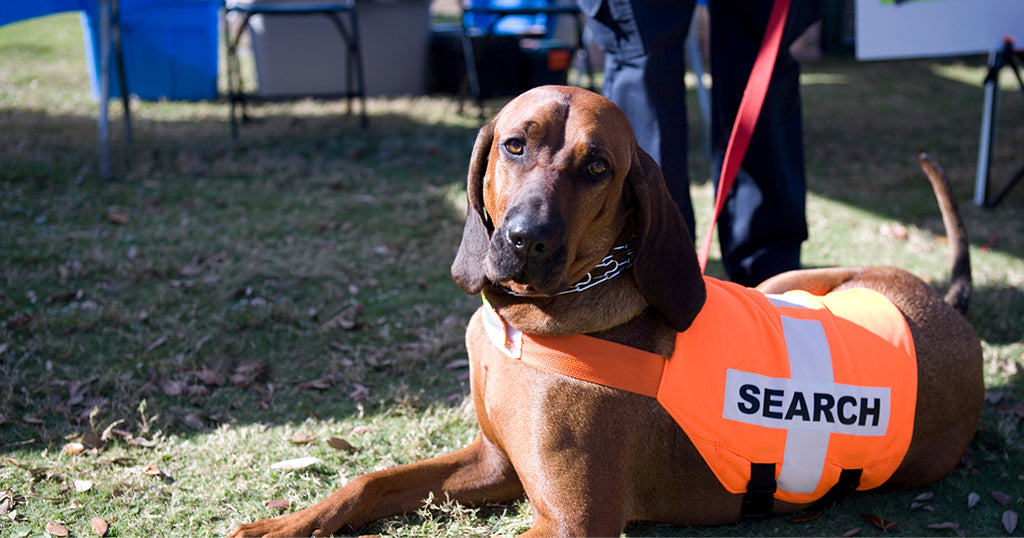Police dogs are known for their loyalty, bravery, obedient nature, and exceptional senses. These highly intelligent canines assist law enforcement agencies with tasks such as drug and explosive detection, tracking missing persons or suspects, apprehending criminals, and ensuring public safety.
Certain dog breeds are better suited for police work than others—they must be intelligent and highly trainable, have good physical strength and stamina, and have a good sense of smell, among other traits. Popular police dog breeds are typically larger dogs like German shepherds, Labrador Retrievers, Belgian Malinois, and other large breed dogs.
What Do Police Dogs Do?
Police dogs—also referred to as K9 units—are specially trained to assist police officers in their work. Because they have such a strong sense of smell, these working dogs can detect drugs, crime scene evidence, and explosives; and even find people who are lost or hiding. They can pick up scent trails that aren't detectable by humans, making them especially important for search and rescue missions and criminal investigations.
Suspect Apprehension
One important role of a police dog is to apprehend suspects in a way that minimizes harm to both the suspect and the officers involved. Police dogs are taught to hold a suspect in place rather than to bite as a first response, ensuring the individual can be taken into custody safely.
When a suspect sees a police dog present, it can make them think twice about attempting to flee, as these breeds are incredibly fast. With special commands from their handler, these dogs can quickly subdue a suspect and mitigate potentially dangerous situations.
Drug Detection
Thanks to their incredible sense of smell, police dogs are great at detecting narcotics. They are trained to recognize specific odors associated with drugs like marijuana, cocaine, methamphetamine, heroin, and ecstasy, among others.
When a police dog indicates the presence of drugs—often by sitting, staying, or signaling in a particular way—it allows law enforcement officers to conduct a search based on probable cause. This is an effective tactic for routine traffic stops and building searches, but also for larger-scale drug operations aimed at combatting drug trafficking and distribution.
Airport Safety
You may have noticed a police dog in the airport as you go through the security line. One of the most important roles of police dogs in airports is detecting explosives. They patrol terminals, luggage handling areas, and cargo facilities to sniff out potential threats, preventing terror attacks and ensuring the safety of passengers and staff.
In addition to searching for explosives, they inspect luggage, cargo, and even passengers (in a non-invasive manner) for illegal substances such as drugs people may be attempting to transport.
Search and Rescue Missions
Search and rescue dogs are trained to follow a person's scent, often for long distances. They can detect a human scent sometimes days after a person has gone missing, making them crucial in rescue operations, especially in cases involving vulnerable individuals like children or the elderly.
The dog is usually given a piece of clothing belonging to the missing person, which helps to familiarize them with the specific scent they need to track. Once on the scent, these dogs can cover large areas much more efficiently than humans ever could.
Best Breeds for Police Dogs
1. German Shepherd: Intelligence and Versatility

German Shepherds are very popular as police dogs because they are smart, incredibly fast, and can assist with many different tasks. They are great at apprehending suspects, detecting drugs and bombs, and keeping their handlers safe. They are also very loyal and brave, which makes them a top choice for law enforcement officers.
-
Average Size/Weight: Males weigh around 65-90 pounds and females 50-70 pounds and are an average of 22-26 inches tall at the shoulder.
-
Best Trait: Intelligence—they can be easily trained for many tasks.
2. Belgian Malinois: Agility and Intelligence

Belgian Malinois make a great police dog breed because of their exceptional agility and sharp minds, making them great for jobs that require quick action and smart decision-making, such as tactical operations and narcotics detection. They're incredibly responsive and deeply committed to their work, making them them invaluable in the field of police work.
-
Average Size/Weight: Males weigh about 60-80 pounds and females 40-60 pounds, with a height range of 22-26 inches at the shoulder.
-
Best Trait: Agility—Belgian Malinois move with incredible speed and precision.
3. Labrador Retriever: Friendly and Energetic

Labrador Retrievers are known for their friendly temperament and endless energy, which makes them excellent at finding missing people as well as drug and bomb detection. While you may not think of friendliness as a trait in good police dogs, their approachable demeanor and eagerness to please make a labrador retriever great for roles that involve interaction with the public or tasks requiring sustained focus and enthusiasm.
-
Average Size/Weight: Males weigh around 65-80 pounds and females 55-70 pounds, standing 21.5-24.5 inches tall at the shoulder.
-
Best Trait: Friendliness—they are approachable and gentle.
4. Dutch Shepherd: Diligent and Agile

Dutch Shepherds are hardworking and agile dogs, known for their obedience, herding, and good police work. Their adaptability and eager-to-please attitude make them excellent at following complex commands and working in various law enforcement environments.
-
Average Size/Weight: Males and females typically weigh 50-70 pounds and stand 21.5-24.5 inches tall at the shoulder.
-
Best Trait: Diligence—they are consistent and reliable workers in any task they're trained for.
5. Bloodhound: Exceptional Scent Tracking Abilities

Bloodhounds have exceptional scent-tracking abilities, making them a go-to breed for finding missing persons or tracking suspects over long distances. Their sense of smell is so acute that they can follow a scent trail that is days old.
-
Average Size/Weight: Males weigh around 90-110 pounds and females 80-100 pounds, with a height of 23-27 inches at the shoulder.
-
Best Trait: Scent tracking—they can track a scent over long distances and time, making them a popular breed for search missions.
6. Belgian Tervuren: Intelligent and Loyal

Belgian Tervuren are known for their intelligence and loyalty, traits that make them excellent police dogs. They excel in obedience, tracking, and protection work, all important skills for a law enforcement dog. Their adaptability and eagerness to please make them great for a wide range of law enforcement duties.
-
Average Size/Weight: Males weigh around 55-75 pounds and females 45-60 pounds, standing 22-26 inches tall at the shoulder.
-
Best Trait: Loyalty—they are highly devoted to their handlers, making them reliable and trusted partners in the field.
What Happens When Police Dogs Retire?
Typically, police dog breeds retire around the age of 8 to 10, though this can depend on the dog's physical condition and the demands of their specific duties. The most common scenario is for the retiring police dog to be adopted by their handler. The bond formed between the handler and the dog during their service together is significant, and many handlers choose to provide a forever home for their loyal partners in retirement.
If the handler is unable to adopt the dog, the next option is often adoption by a former officer or someone closely associated with law enforcement who understands the unique needs of a retired police dog. There are also organizations and facilities dedicated to caring for retired service animals, including police dogs. These places understand the unique needs of working dogs and can provide a comfortable retirement, although this option is less common as most prefer the dogs to enjoy a family environment.
Tips For Caring for a Retired Police Dog
Caring for a retired police dog, especially those from extra large breeds, requires attention to their physical and emotional needs. These dogs have spent their lives serving and now deserve a retirement filled with comfort and care.
Here are some tips to help ensure a retired police dog enjoys their golden years:
-
Veterinary Care: Regular check-ups are important to monitor the health of a retired police dog. This includes vaccinations, dental care, and screenings for age-related conditions such as arthritis or hip dysplasia.
-
Joint Care: Given their active past, retired police dogs are prone to joint issues. Supplements containing glucosamine, chondroitin, and MSM can support joint health and reduce discomfort, and an orthopedic bed provides support for aging joints and helps to prevent discomfort.
-
Nutrition: A balanced diet tailored to their age, size, and health needs is crucial. As their metabolism slows down, they may require fewer calories to avoid weight gain, which can further strain their joints.
-
Exercise: While their days of rigorous activity are behind them, retired police dogs still need regular, moderate exercise to maintain their health and mobility. Short walks, gentle play sessions, and swimming (if possible) are excellent low-impact activities.
-
Mental Stimulation: Retirement doesn't mean they lose their intelligence or their need for mental engagement. Puzzle toys, scent games, and gentle training sessions can keep their mind sharp and prevent boredom.
-
Comfort and Love: Most importantly, retired police dogs need plenty of love and comfort in their retirement. They've spent their lives serving and forming strong bonds with their handlers. Continuing to provide them with affection, attention, and a safe, comfortable environment will ensure they enjoy their final years.





